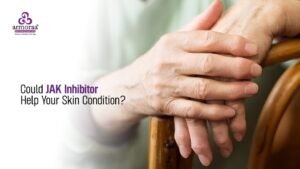Your Friend’s Cream Worked for Them—But
Here’s Why It May Fail You
Ever done this before?
You notice an itchy red patch on your skin. You go to the nearest pharmacy and ask for “something for itching.” The pharmacist hands you a cream. Or maybe a friend tells you, “This worked for me—try it!”
At first, you feel better—the itching reduces. But two weeks later, the rash had spread. It’s bigger, angrier, and maybe even popping up in new spots.
Sound familiar?
If yes, there’s a big chance it could be a fungal infection (tinea). And the cream you used may have contained steroids, which can actually make fungal Infections worsen.
When a fungal rash is treated with the wrong cream (especially steroid-based
ones), it changes its appearance. Doctors call this Tinea Incognito, which simply means “a fungal infection in disguise.”
Instead of clear ring-shaped patches, the rash becomes:
- Bigger
- More widespread
- Harder to recognize
The steroid temporarily reduces the inflammation and itching. However, it also suppresses the skin’s immune response, allowing the fungus to spread unchecked. So while the cream gives quick relief in the beginning, it’s only masking the symptoms and giving the fungus more power to spread. Patients may continue to use the steroid cream because of the initial relief, creating a vicious cycle of temporary comfort and long term harm.

Why Is This So Common in India?
Here’s the uncomfortable truth behind those easy-to-get creams:
1. Unethical Mixes and Irrational Combinations
Many creams available at pharmacies in India are fixed-dose combinations (FDCs) that mix steroids, antifungals, and antibacterials — a dangerously irrational cocktail. Despite regulatory attempts to ban such combinations, they remain widely available and popular.
2. Sold Over-the-Counter—Without Any Prescription
Although topical steroids ought to be sold only with a valid prescription under Schedule H, loopholes allow them to be sold freely. Even powerful steroids and FDCs continue to be widely dispensed, often without prescriptions, sometimes repeatedly refilling from old prescriptions.
3. Sharing Prescriptions and Reusing Old Creams
It’s common for people to reuse old prescriptions or share creams with friends and family, assuming similar-looking rashes are the same. In some studies, up to 33% of topical steroid use came from friends or relatives, and many are reusing old prescriptions.
4. Quick Relief Trumps Safe Treatment
These combination creams often provide rapid symptom relief at a lower cost than pure antifungals. That makes them popular among users seeking fast results—even if it comes at the cost of proper treatment.
Not All Rashes Are the Same
Itch, redness, or rash may mimic various conditions—eczema, psoriasis, or allergic dermatitis. However, fungal infections require targeted antifungal treatment.
Not all rashes are same. What worked for your friend’s eczema will not work for your fungal infection!
Guidance for Patients: Best Practices
Pharmacists must avoid handing out creams without a proper prescription. But change also starts with patients being aware and proactive. Here’s how you can play your part:
Don’t self-medicate rashy skin unknowingly.
Consult a dermatologist and get yourself properly diagnosed.
Report misuse when you see it
- If a pharmacy is selling steroid creams without a prescription, you can point
out that it is against medical guidelines. - In India, organizations like ITATSA (Indian Association of Dermatologists,
Venereologists & Leprologists – Task Force Against Topical Steroid Abuse)
are working to curb this misuse.
Patients can also be supported by:
- Spreading awareness among family and friends.
- Avoiding and discouraging sharing of creams.
- Highlighting misuse to their dermatologist, who can guide reporting.
If you have a rash that’s not settling down, don’t experiment. If an OTC cream makes things worse instead of better—it’s time to stop and seek professional care. The right treatment early can save you weeks—or even months of frustration.




